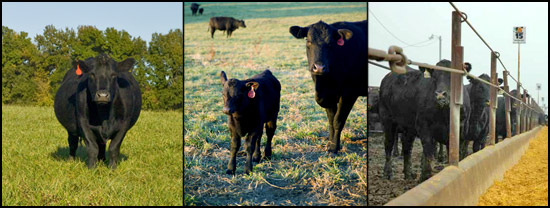 It All Matters
It All Matters
Quality beef affected by nutrition, environment, genetics and more.
What? How? When? Where?
Ron Scott, director of research for Land O' Lakes Purina Feed, said those variables throughout a calf's life factor into final beef quality.
"There are many things besides just genetics and time on feed that affect marbling and we now know, we can say with confidence, that it is a lifetime event," said Scott, who addressed attendees at last fall's Feeding Quality Forums in South Sioux City, Neb., and Garden City, Kan.
What & How
Although it's not all about genetics, that's where quality gets its start. Scott used Japanese Wagyu cattle as an example.
"They are different critters because they can marble on higher-roughage diets than other breeds," he said. "They also have more DNA that will make adipocytes, or cells that will become marbling."
So, to produce high-quality beef, one must start with cattle that have the potential to reach that end point.
Then they have to feed them right.
"If we can increase glucose, we have a chance of affecting marbling," Scott said, noting that grain-based diets result in more glucose than forage-based ones. Glucose is the precursor that causes cells to differentiate into marbling cells.
"Once you create them, then we have to fill them up," he said.
Creep feeding, for example, could help, but starch seems to be the key.
When
And it's not just diet type, but when it's fed.
Fetal programming is the idea that future performance and quality is affected by what a calf's mother eats during pregnancy.
"The beef cow is truly the most undernourished female we have in the livestock industry during gestation," Scott said. Nebraska research shows percent Choice increased 5 points in the progeny of cows supplemented in the last trimester, and premium Choice rose 13 points, from 27% to 40%.
"Range nutritionists talk about wanting cows to maintain their condition during winter so they can get rebred," he said. "We never really talk about maintaining their condition so their calf crop will perform. That's a big deal."
Once the calves hit the ground, it seems getting them on feed early can move the quality needle. Studies at the University of Illinois show early-weaning calves on corn-based diets could more than double the number reaching the premium Choice category.
"Basically, they're maximizing the lifetime grain intake of the calf, so we're getting more corn into those cattle early on in their life," he said.
Regardless of weaning age, the plane of nutrition should continue on a steady or upward trek.
"With stocker cattle, the key thing that we like to see is consistency on average daily gain," Scott said. "Any time a calf goes backwards in gain, then you're running the risk of reducing energy intake and you risk pulling out some of the marbling."
More than just nutrition affects those gains.
Where
"We need to recognize that fat cells are very dynamic, which means they can be filled and, just like our gas tank, they can be emptied," he said. "How can they be emptied? With sickness, nutrition, environment and management."
Where those cattle are fed and how they minimize outside stressors can have a huge impact.
"If you talk to feeders in the southwest part of the U.S., one environmental factor that they hate is dust," Scott said. "Why? Cattle inhale the dust, get sick and don't eat. Cattle that don't eat aren't going to grade."
Moisture might calm the dust, but it introduces other problems: "A wet hair coat and mud. And mud on a wet hair coat increases maintenance requirements; therefore, you have less feed left over to go toward gain and marbling."
Iowa's Tri-County Steer Carcass Futurity data points to health's role in the process. Compared to untreated cattle, there's nearly a 15-point drop in cattle grading Choice and higher when they must be treated twice.
"Keeping cattle healthy is vital if we're trying to maximize marbling," he said.
All of these factors work together, and the final report card comes from a packing plant grader.
"If you're feeding or raising cattle, we need to know more than just the pay weight," Scott said. "We need to understand nutrition at the cow-herd level and all the interactions that go on to affect marbling."
The forums were co-sponsored by Certified Angus Beef LLC (CAB), Pfizer Animal Health, Land O' Lakes Purina Feed LLC and Feedlot magazine. BeefCast covered the meetings, making audio and PowerPoint versions of the presentations available at http://www.beefcast.com/2009-certified-angus-beef-feeding-quality-forum.
Comment on this article.




